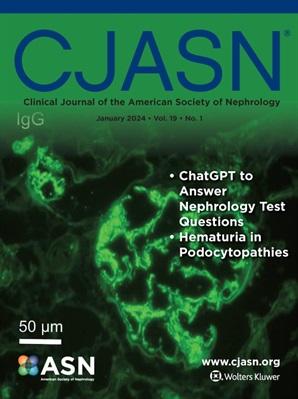The Association of Fibrate Use with Kidney Outcomes and Mortality.
IF 8.5
1区 医学
Q1 UROLOGY & NEPHROLOGY
Clinical Journal of the American Society of Nephrology
Pub Date : 2025-04-07
DOI:10.2215/CJN.0000000683
引用次数: 0
使用菲贝特与肾脏结果和死亡率的关系
背景:使用非贝特类药物会导致血清肌酐急性升高,因此在随访时间较短的研究中很难评估非贝特类药物对肾脏的影响。此外,对某些肾脏结果的研究有限,过去的研究结果也不尽相同。本研究的目的是在一个大型的美国退伍军人全国队列中,研究使用非贝特类药物与慢性肾病(CKD)、终末期肾病(ESKD)和死亡率之间的关系:我们进行了一项回顾性队列研究,以探讨在长达 14 年的随访过程中,新处方纤维酸盐药物与慢性肾脏病、终末期肾脏病和死亡率之间的关系。患者(n=688,382)选自退伍军人管理局(VA)国家研究数据库。通过Cox比例危险模型和Fine-Gray模型对人口统计学、主要合并症、实验室测量(包括基线估计肾小球滤过率(eGFR)、白蛋白尿和药物)进行调整后,对相关性进行了研究:我们发现了 58,773 例新的纤维酸盐使用者。总体平均(标准差 [SD])年龄为 59 (13) 岁,其中女性占 7%,黑人占 18%,西班牙裔占 7%。使用非贝特类药物的人更可能是男性、白人、当前吸烟者,而且合并症发生率更高。在完全调整模型中,使用(与不使用)纤维酸盐与较低的死亡风险(危险比[HR]:0.91,95%保密区间[CI]:0.89-0.93)和ESKD(0.80,0.71-0.92)相关,但与较高的事件性CKD风险(1.21,1.19-1.24)相关:结论:在这一大型美国退伍军人全国队列中,由于随访时间较长,使用纤维酸盐与较高的突发慢性肾脏病风险有关,但与较低的ESKD和死亡率风险有关。还需要进一步的研究来证实纤维酸盐对肾功能和生存的潜在益处。
本文章由计算机程序翻译,如有差异,请以英文原文为准。
求助全文
约1分钟内获得全文
求助全文
来源期刊
CiteScore
12.20
自引率
3.10%
发文量
514
审稿时长
3-6 weeks
期刊介绍:
The Clinical Journal of the American Society of Nephrology strives to establish itself as the foremost authority in communicating and influencing advances in clinical nephrology by (1) swiftly and effectively disseminating pivotal developments in clinical and translational research in nephrology, encompassing innovations in research methods and care delivery; (2) providing context for these advances in relation to future research directions and patient care; and (3) becoming a key voice on issues with potential implications for the clinical practice of nephrology, particularly within the United States. Original manuscript topics cover a range of areas, including Acid/Base and Electrolyte Disorders, Acute Kidney Injury and ICU Nephrology, Chronic Kidney Disease, Clinical Nephrology, Cystic Kidney Disease, Diabetes and the Kidney, Genetics, Geriatric and Palliative Nephrology, Glomerular and Tubulointerstitial Diseases, Hypertension, Maintenance Dialysis, Mineral Metabolism, Nephrolithiasis, and Transplantation.

 求助内容:
求助内容: 应助结果提醒方式:
应助结果提醒方式:


